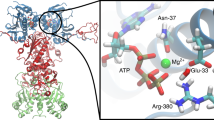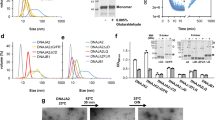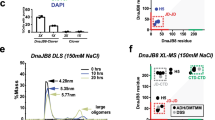Abstract
Hsp70 chaperones interact with a wide spectrum of substrates ranging from unfolded to natively folded and aggregated proteins. Structural evidence suggests that bound substrates are entirely enclosed in a β-sheet cavity covered by a helical lid, which requires structural rearrangements including lid opening to allow substrate access. We analyzed the mechanics of the lid movement of bacterial DnaK by disulfide fixation of lid elements to the β-sheet and by electron paramagnetic resonance spectroscopy using spin labels in the lid and β-sheet. Our results indicate that the lid-forming helix B adopts at least three conformational states and, notably, does not close over bound proteins, implying that DnaK does not only bind to extended peptide stretches of protein substrates but can also accommodate regions with substantial tertiary structure. This flexible binding mechanism provides a basis for the broad spectrum of substrate conformers of Hsp70s.
This is a preview of subscription content, access via your institution
Access options
Subscribe to this journal
Receive 12 print issues and online access
$189.00 per year
only $15.75 per issue
Buy this article
- Purchase on Springer Link
- Instant access to full article PDF
Prices may be subject to local taxes which are calculated during checkout







Similar content being viewed by others
Accession codes
References
Hartl, F.U. & Hayer-Hartl, M. Molecular chaperones in the cytosol: from nascent chain to folded protein. Science 295, 1852–1858 (2002).
Mayer, M.P. & Bukau, B. Hsp70 chaperones: cellular functions and molecular mechanism. Cell. Mol. Life Sci. 62, 670–684 (2005).
Bukau, B., Deuerling, E., Pfund, C. & Craig, E.A. Getting newly synthesized proteins into shape. Cell 101, 119–122 (2000).
Gething, M.-J.H. & Sambrook, J.F. Protein folding in the cell. Nature 355, 33–45 (1992).
Young, J.C., Agashe, V.R., Siegers, K. & Hartl, F.U. Pathways of chaperone-mediated protein folding in the cytosol. Nat. Rev. Mol. Cell Biol. 5, 781–791 (2004).
Mayer, M.P., Rudiger, S. & Bukau, B. Molecular basis for interactions of the DnaK chaperone with substrates. Biol. Chem. 381, 877–885 (2000).
Karzai, A.W. & McMacken, R. A bipartite signaling mechanism involved in DnaJ-mediated activation of the Escherichia coli DnaK protein. J. Biol. Chem. 271, 11236–11246 (1996).
Liberek, K., Marszalek, J., Ang, D., Georgopoulos, C. & Zylicz, M. Escherichia coli DnaJ and GrpE heat shock proteins jointly stimulate ATPase activity of DnaK. Proc. Natl. Acad. Sci. USA 88, 2874–2878 (1991).
McCarty, J.S., Buchberger, A., Reinstein, J. & Bukau, B. The role of ATP in the functional cycle of the DnaK chaperone system. J. Mol. Biol. 249, 126–137 (1995).
Zhu, X. et al. Structural analysis of substrate binding by the molecular chaperone DnaK. Science 272, 1606–1614 (1996).
Cupp-Vickery, J.R., Peterson, J.C., Ta, D.T. & Vickery, L.E. Crystal structure of the molecular chaperone HscA substrate binding domain complexed with the IscU recognition peptide ELPPVKIHC. J. Mol. Biol. 342, 1265–1278 (2004).
Jiang, J., Prasad, K., Lafer, E.M. & Sousa, R. Structural basis of interdomain communication in the hsc70 chaperone. Mol. Cell 20, 513–524 (2005).
Morshauser, R.C. et al. High-resolution solution structure of the 18 kDa substrate-binding domain of the mammalian chaperone protein Hsc70. J. Mol. Biol. 289, 1387–1403 (1999).
Pellecchia, M. et al. Structural insights into substrate binding by the molecular chaperone DnaK. Nat. Struct. Biol. 7, 298–303 (2000).
Stevens, S.Y., Cai, S., Pellecchia, M. & Zuiderweg, E.R. The solution structure of the bacterial HSP70 chaperone protein domain DnaK(393–507) in complex with the peptide NRLLLTG. Protein Sci. 12, 2588–2596 (2003).
Wang, H. et al. NMR solution structure of the 21 kDa chaperone protein DnaK substrate binding domain: a preview of chaperone-protein interaction. Biochemistry 37, 7929–7940 (1998).
Liu, Q. & Hendrickson, W.A. Insights into hsp70 chaperone activity from a crystal structure of the yeast Hsp110 Sse1. Cell 131, 106–120 (2007).
Fernández-Sáiz, V., Moro, F., Arizmendi, J.M., Acebron, S.P. & Muga, A. Ionic contacts at DnaK substrate binding domain involved in the allosteric regulation of lid dynamics. J. Biol. Chem. 281, 7479–7488 (2006).
Gisler, S.M., Pierpaoli, E.V. & Christen, P. Catapult mechanism renders the chaperone action of Hsp70 unidirectional. J. Mol. Biol. 279, 833–840 (1998).
Schmid, D., Baici, A., Gehring, H. & Christen, P. Kinetics of molecular chaperone action. Science 263, 971–973 (1994).
Vogel, M., Bukau, B. & Mayer, M.P. Allosteric regulation of Hsp70 chaperones by a proline switch. Mol. Cell 21, 359–367 (2006).
Grossman, A.D., Straus, D.B., Walter, W.A. & Gross, C.A. σ32 synthesis can regulate the synthesis of heat shock proteins in Escherichia coli. Genes Dev. 1, 179–184 (1987).
Straus, D., Walter, W. & Gross, C.A. DnaK, DnaJ, and GrpE heat shock proteins negatively regulate heat shock gene expression by controlling the synthesis and stability of σ32. Genes Dev. 4, 2202–2209 (1990).
Tilly, K., McKittrick, N., Zylicz, M. & Georgopoulos, C. The DnaK protein modulates the heat-shock response of Escherichia coli. Cell 34, 641–646 (1983).
Gamer, J., Bujard, H. & Bukau, B. Physical interaction between heat shock proteins DnaK, DnaJ, and GrpE and the bacterial heat shock transcription factor sigma 32. Cell 69, 833–842 (1992).
Gamer, J. et al. A cycle of binding and release of the DnaK, DnaJ and GrpE chaperones regulates activity of the Escherichia coli heat shock transcription factor sigma32. EMBO J. 15, 607–617 (1996).
Liberek, K., Galitski, T.P., Zylicz, M. & Georgopoulos, C. The DnaK chaperone modulates the heat shock response of Escherichia coli by binding to the σ32 transcription factor. Proc. Natl. Acad. Sci. USA 89, 3516–3520 (1992).
Liberek, K., Wall, D. & Georgopoulos, C. The DnaJ chaperone catalytically activates the DnaK chaperone to preferentially bind the σ32 heat shock transcriptional regulator. Proc. Natl. Acad. Sci. USA 92, 6224–6228 (1995).
Rodriguez, F. et al. Molecular basis for regulation of the heat shock transcription factor σ32 by the DnaK and DnaJ chaperones. Mol. Cell 32, 347–358 (2008).
Mayer, M.P. et al. Multistep mechanism of substrate binding determines chaperone activity of Hsp70. Nat. Struct. Biol. 7, 586–593 (2000).
Buchberger, A. et al. Nucleotide-induced conformational changes in the ATPase and substrate binding domains of the DnaK chaperone provide evidence for interdomain communication. J. Biol. Chem. 270, 16903–16910 (1995).
Moro, F., Fernandez, V. & Muga, A. Interdomain interaction through helices A and B of DnaK peptide binding domain. FEBS Lett. 533, 119–123 (2003).
Altenbach, C., Oh, K.J., Trabanino, R.J., Hideg, K. & Hubbell, W.L. Estimation of inter-residue distances in spin labeled proteins at physiological temperatures: experimental strategies and practical limitations. Biochemistry 40, 15471–15482 (2001).
Ishiai, M., Wada, C., Kawasaki, Y. & Yura, T. Replication initiator protein RepE of mini-F plasmid: functional differentiation between monomers (initiator) and dimers (autogenous repressor). Proc. Natl. Acad. Sci. USA 91, 3839–3843 (1994).
Swain, J.F. et al. Hsp70 chaperone ligands control domain association via an allosteric mechanism mediated by the interdomain linker. Mol. Cell 26, 27–39 (2007).
Rist, W., Graf, C., Bukau, B. & Mayer, M.P. Amide hydrogen exchange reveals conformational changes in hsp70 chaperones important for allosteric regulation. J. Biol. Chem. 281, 16493–16501 (2006).
Rüdiger, S., Germeroth, L., Schneider-Mergener, J. & Bukau, B. Substrate specificity of the DnaK chaperone determined by screening cellulose-bound peptide libraries. EMBO J. 16, 1501–1507 (1997).
Jones, G.W. & Tuite, M.F. Chaperoning prions: the cellular machinery for propagating an infectious protein? Bioessays 27, 823–832 (2005).
Laufen, T. et al. Mechanism of regulation of hsp70 chaperones by DnaJ cochaperones. Proc. Natl. Acad. Sci. USA 96, 5452–5457 (1999).
Buchberger, A., Schroder, H., Buttner, M., Valencia, A. & Bukau, B. A conserved loop in the ATPase domain of the DnaK chaperone is essential for stable binding of GrpE. Nat. Struct. Biol. 1, 95–101 (1994).
Andréasson, C., Fiaux, J., Rampelt, H., Mayer, M.P. & Bukau, B. Hsp110 is a nucleotide-activated exchange factor for Hsp70. J. Biol. Chem. 283, 8877–8884 (2008).
Kunkel, T.A., Bebenek, K. & McClary, J. Efficient site-directed mutagenesis using uracil-containing DNA. Methods Enzymol. 204, 125–139 (1991).
Theyssen, H., Schuster, H.P., Packschies, L., Bukau, B. & Reinstein, J. The second step of ATP binding to DnaK induces peptide release. J. Mol. Biol. 263, 657–670 (1996).
Arsène, F. et al. Role of region C in regulation of the heat shock gene-specific sigma factor of Escherichia coli, σ32. J. Bacteriol. 181, 3552–3561 (1999).
Mayer, M.P., Laufen, T., Paal, K., McCarty, J.S. & Bukau, B. Investigation of the interaction between DnaK and DnaJ by surface plasmon resonance spectroscopy. J. Mol. Biol. 289, 1131–1144 (1999).
Szabo, A. et al. The ATP hydrolysis-dependent reaction cycle of the Escherichia coli Hsp70 system DnaK, DnaJ, and GrpE. Proc. Natl. Acad. Sci. USA 91, 10345–10349 (1994).
Altenbach, C., Cai, K., Klein-Seetharaman, J., Khorana, H.G. & Hubbell, W.L. Structure and function in rhodopsin: mapping light-dependent changes in distance between residue 65 in helix TM1 and residues in the sequence 306–319 at the cytoplasmic end of helix TM7 and in helix H8. Biochemistry 40, 15483–15492 (2001).
Columbus, L., Kalai, T., Jeko, J., Hideg, K. & Hubbell, W.L. Molecular motion of spin labeled side chains in alpha-helices: analysis by variation of side chain structure. Biochemistry 40, 3828–3846 (2001).
McHaourab, H.S., Lietzow, M.A., Hideg, K. & Hubbell, W.L. Motion of spin-labeled side chains in T4 lysozyme. Correlation with protein structure and dynamics. Biochemistry 35, 7692–7704 (1996).
Langen, R., Oh, K.J., Cascio, D. & Hubbell, W.L. Crystal structures of spin labeled T4 lysozyme mutants: implications for the interpretation of EPR spectra in terms of structure. Biochemistry 39, 8396–8405 (2000).
McCarty, J.S. et al. Regulatory region C of the E. coli heat shock transcription factor, σ32, constitutes a DnaK binding site and is conserved among eubacteria. J. Mol. Biol. 256, 829–837 (1996).
Acknowledgements
We are grateful to F. Rodriguez for providing RepE, C. Altenbach for providing the fitting software and T. Ruppert for mass spectrometry. We thank S. R. Scholz for critical reading of the manuscript and S. Miller for help with figure preparation. We thank CellNetworks for providing the FTIR spectrometer. This work was supported by the Deutsche Forschungsgemeinschaft (SFB638 and MA 1278/4-1 to M.P.M.) and a Kekulé fellowship of the Fonds der Chemischen Industrie to R.S.
Author information
Authors and Affiliations
Contributions
R.S. designed, performed and interpreted the experiments in Figures 2,3,4 and Figure 6, Table 1, Supplementary Figures 1,4,5 and 9 and Supplementary Table 1. A.H.E. designed, performed and interpreted the experiments in Figure 5 and Supplementary Figures 6–8. B.B. designed the experiments and supervised R.S. and A.H.E. M.P.M. designed all mutant proteins; designed, performed and interpreted experiments in Supplementary Figure 2; was involved in the design and interpretation of all experiments; and supervised R.S. and A.H.E. All authors prepared figures and wrote the manuscript.
Corresponding authors
Ethics declarations
Competing interests
The authors declare no competing financial interests.
Supplementary information
Supplementary Text and Figures
Supplementary Figures 1–9 and Supplementary Table 1 (PDF 1780 kb)
Rights and permissions
About this article
Cite this article
Schlecht, R., Erbse, A., Bukau, B. et al. Mechanics of Hsp70 chaperones enables differential interaction with client proteins. Nat Struct Mol Biol 18, 345–351 (2011). https://doi.org/10.1038/nsmb.2006
Received:
Accepted:
Published:
Issue Date:
DOI: https://doi.org/10.1038/nsmb.2006
This article is cited by
-
Direct observation of chaperone-modulated talin mechanics with single-molecule resolution
Communications Biology (2022)
-
Co-diet supplementation of low density polyethylene and honeybee wax did not influence the core gut bacteria and associated enzymes of Galleria mellonella larvae (Lepidoptera: Pyralidae)
International Microbiology (2022)
-
Specificity of AMPylation of the human chaperone BiP is mediated by TPR motifs of FICD
Nature Communications (2021)
-
Molecular chaperones and their denaturing effect on client proteins
Journal of Biomolecular NMR (2021)
-
The functions and regulation of heat shock proteins; key orchestrators of proteostasis and the heat shock response
Archives of Toxicology (2021)



